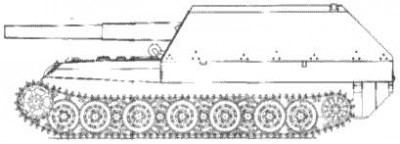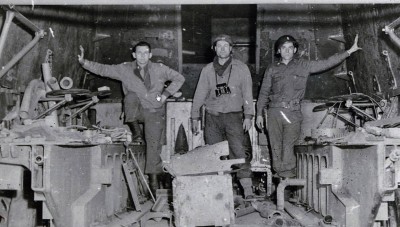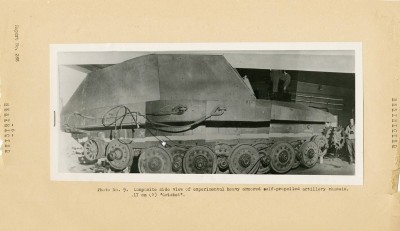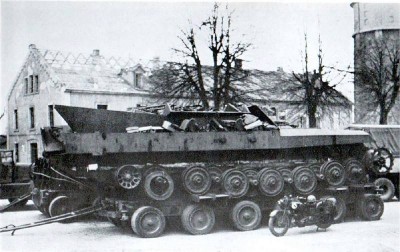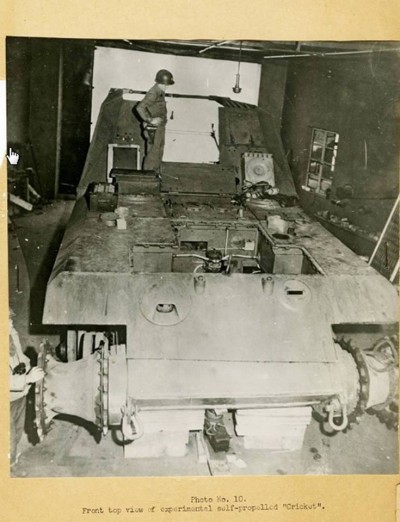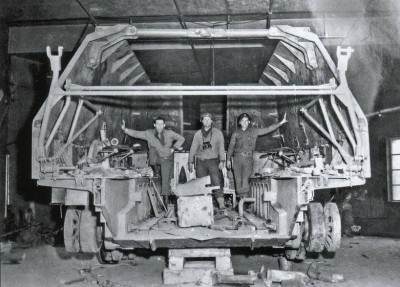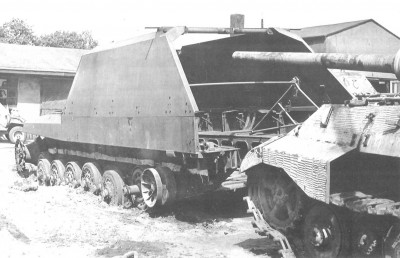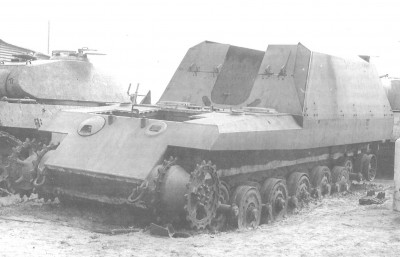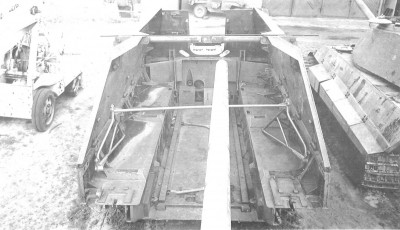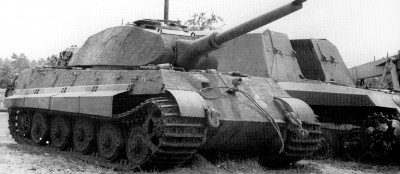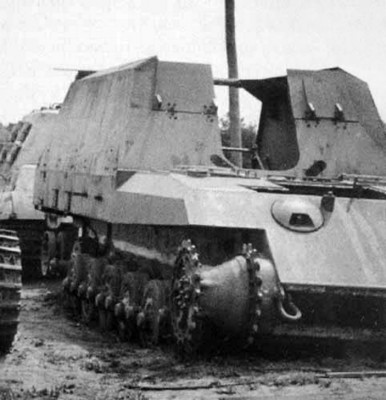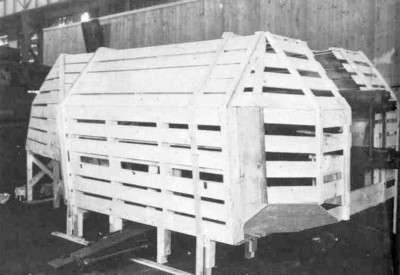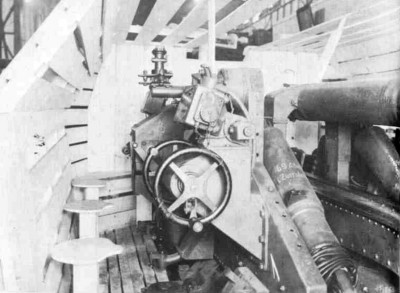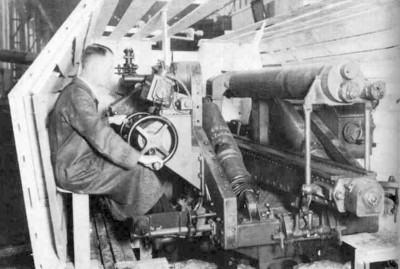| Název: Name: | Grille 17 | Grille 17 |
| Originální název: Original Name: | Geschützwagen Tiger für 17 cm Kanone 72 (Sf.) | |
| Kategorie: Category: | ťažký samohybný kanón | heavy self-proppelled gun |
| Výrobce: Producer: | DD.MM.1945-DD.MM.1945 Fried. Krupp AG, Essen | |
| Období výroby: Production Period: | DD.MM.RRRR-DD.MM.RRRR | |
| Vyrobeno kusů: Number of Produced: | 1 nedokončený prototyp (incomplete prototype) | |
| Prototyp vyroben: Prototype Built: | DD.MM.RRRR | |
| Osádka: Crew: | 8 | |
| Technické údaje: Technical Data: | ||
| Bojová hmotnost: Combat Weight: | 60000 kg | 132277 lb |
| Celková délka: Overall Length: | 13000 mm | 42 ft 7 ¾ in |
| Celková šířka: Overall Width: | 3270 mm | 10 ft 8 ¾ in |
| Celková výška: Overall Height: | 3150 mm | 10 ft 4 in |
| Světlá výška: Ground Clearance: | 500 mm | 1 ft 7 ¾ in |
| Pohon: Propulsion: | ||
| Typ: Type: | Maybach HL 230 P30 (zážihový vodou chladený 12-valec, objemu 23.000 cm3) | Maybach HL 230 P30 (gasoline, water cooled, 12 cylinders, 23.000 cm3) |
| Výkon: Power: | 559.3 kW při 3000 ot/min | 750 bhp at 3000 rpm |
| Převodové ústrojí: Transmission: | Maybach OLVAR EG 40 12 16 B (8+R) | Maybach OLVAR EG 40 12 16 B (8+R) |
| Výkony: Performance: | ||
| Rychlost na silnici: Road Speed: | 45 km/h | 28 mph |
| Rychlost v terénu: Cross-country Speed: | 18 km/h | 11 mph |
| Jízdní dosah po silnici: Cruising Range on Road: | 250 km | 155 mi |
| Jízdní dosah v terénu: Cross-country Cruising Range: | 125 km | 78 mi |
| Překonávání překážek: Obstacles Crossing: | ||
| Svah: Gradient: | 30 ° | 67 % |
| Boční náklon: Side Slope: | ? ° | ? % |
| Překročivost: Trench Crossing: | 3 m | 118 in |
| Výstupnost: Vertical Obstacle: | 0,8 m | 31 in |
| Brodivost: Fording Depth: | 0,7 m | 28 in |
| Výzbroj: Armament: | ||
| Hlavní: Main: | 17 cm Kanone 18 (5 nábojov) | 17 cm Kanone 18 (5 rounds) |
| Vedlejší: Secondary: | MG 34/42 | MG 34/42 |
| Uživatelské státy: User States: | - | - |
| Poznámka: Note: | Pancierovanie Korba: čelo - 30 mm boky a zadok - 16 mm Nadstavba: 16 mm Pásy: Gg 24/800/300 (58+58 článkov v jednom páse dvojdielny článok) | Armor Hull: front - 30 mm sides & rear - 16 mm Superstructure: 16 mm Tracks: Gg 24/800/300 (58+58 links per side - double links) |
| Zdroje: Sources: | Thomas L. Jentz, Hilary Louis Doyle - Artillerie Selbstfahrlafetten 15cm s.I.G.33 auf Pz.Kpfw.I (ohne Aufbau) to Karl Geraet (54 cm), Panzer Tracts no.10, ISBN 0-9708407-5-6 | |
Grille 17
Geschützwagen Tiger für 17 cm Kanone 72 (Sf.)
Grille 17
Geschützwagen Tiger für 17 cm Kanone 72 (Sf.)
The idea to build an extremely destructive self-propelled long-range cannon originated in 1942, when the company Krupp presented on May 6, 1942 the first design of an armored self-propelled gun.
Originally, the use of the tank chassis was considered Tiger I, but at the time of the project it was decided to use the chassis Tiger II. However, it also had to be modified, because the planned armament modified cannon 17 cm Kanone 18 had dimensions that went beyond the capabilities of the original platform Tiger II. Therefore, the carriage was extended by two wheels on each side of the chassis (originally 9, now 11). The power unit and transmission remained the same as the tank Tiger II. Instead of a tower, however, a huge superstructure was created to protect the armament and combat space of the crew from all sides, except for a longitudinal section of the superstructure ceiling, which allowed the elevation of the main weapon. The front body of the superstructure was to be 30 mm thick, the sides and rear wall 16 mm. The emergency supply of ammunition was 5 pieces, the range was 28,000 m with a grenade weight of 68 kg and ammunition with a powder charge weighing 29.15 kg. Using a larger powder charge of 30.5 kg and a light grenade of 62.8 kg, the range was up to 29,600 m. The target ranged from -2 ° + 48 °. The lateral measurement was 5 ° to both sides. The crew consisted of 8 men - driver, commander and 6 men as a cannon operator. A prototype of this giant began to emerge in 1944 and was to be completed in the second quarter of 1944. The Imperial Minister of Industry Dr. Albert Speer September 25, 1944 ordered the presentation of the concept of an unfinished prototype on January 15, 1945. According to the plans, after the start of serial production, 2 pieces of this machine per month were to come off the production lines. However, the machine was not due to raids on Krupp's factory in Essen. The unfinished prototype was on December 7, 1944 ready for navigation and sent to Paderborn. The Panzerstation 96 in Haustenbeck near Paderborn reported an enormous shortage of necessary components on 22.12.1944 for final assembly. Due to the unfavorable situation in the industry, this prototype was never completed and its torso at the end of the war became the prey of the Allies, who found it in Haustenbek. He probably ended up in scrap metal later. Although this machine was criticized for its construction and nonsense, at the end of the war this machine was a prototype for later modern designs of works of the largest calibers.
In addition to the mounting of the 17cm cannon, a version with a mounted 21cm grinder was to be produced at the same time ( Grille 21).
Grille 21
Grille 17
Geschützwagen Tiger für 17 cm Kanone 72 (Sf.)
The idea to build an extremely destructive self-propelled long-range cannon originated in 1942, when the company Krupp presented on May 6, 1942 the first design of an armored self-propelled gun.
Originally, the use of the tank chassis was considered Tiger I, but at the time of the project it was decided to use the chassis Tiger II. However, it also had to be modified, because the planned armament modified cannon 17 cm Kanone 18 had dimensions that went beyond the capabilities of the original platform Tiger II. Therefore, the carriage was extended by two wheels on each side of the chassis (originally 9, now 11). The power unit and transmission remained the same as the tank Tiger II. Instead of a tower, however, a huge superstructure was created to protect the armament and combat space of the crew from all sides, except for a longitudinal section of the superstructure ceiling, which allowed the elevation of the main weapon. The front body of the superstructure was to be 30 mm thick, the sides and rear wall 16 mm. The emergency supply of ammunition was 5 pieces, the range was 28,000 m with a grenade weight of 68 kg and ammunition with a powder charge weighing 29.15 kg. Using a larger powder charge of 30.5 kg and a light grenade of 62.8 kg, the range was up to 29,600 m. The target ranged from -2 ° + 48 °. The lateral measurement was 5 ° to both sides. The crew consisted of 8 men - driver, commander and 6 men as a cannon operator. A prototype of this giant began to emerge in 1944 and was to be completed in the second quarter of 1944. The Imperial Minister of Industry Dr. Albert Speer September 25, 1944 ordered the presentation of the concept of an unfinished prototype on January 15, 1945. According to the plans, after the start of serial production, 2 pieces of this machine per month were to come off the production lines. However, the machine was not due to raids on Krupp's factory in Essen. The unfinished prototype was on December 7, 1944 ready for navigation and sent to Paderborn. The Panzerstation 96 in Haustenbeck near Paderborn reported an enormous shortage of necessary components on 22.12.1944 for final assembly. Due to the unfavorable situation in the industry, this prototype was never completed and its torso at the end of the war became the prey of the Allies, who found it in Haustenbek. He probably ended up in scrap metal later. Although this machine was criticized for its construction and nonsense, at the end of the war this machine was a prototype for later modern designs of works of the largest calibers.
In addition to the mounting of the 17cm cannon, a version with a mounted 21cm grinder was to be produced at the same time ( Grille 21).
| Period | - |
| Type | - |
| Camouflage | - |
| Country | - |
| Production No. | - |
| Poznávací značka / evidenční číslo | - |
| Tactical marking | - |
| Name | - |
| Unit | - |
| Date (DD.MM.RRRR) | DD.MM.RRRR |
| Author | - |
| Print size / 300 DPI | - |
| Published with authors permit | - |
| Author Website | - |
Grille 21
| Period | - |
| Type | - |
| Camouflage | - |
| Country | - |
| Production No. | - |
| Poznávací značka / evidenční číslo | - |
| Tactical marking | - |
| Name | - |
| Unit | - |
| Date (DD.MM.RRRR) | DD.MM.RRRR |
| Author | - |
| Print size / 300 DPI | - |
| Published with authors permit | - |
| Author Website | - |
Grille 17
Reklama
This post has not been translated to English yet. Please use the TRANSLATE button above to see machine translation of this post.
*zdroj:
NARA
| Period | - |
| Type | - |
| Camouflage | - |
| Country | - |
| Production No. | - |
| Poznávací značka / evidenční číslo | - |
| Tactical marking | - |
| Name | - |
| Unit | - |
| Date (DD.MM.RRRR) | DD.MM.RRRR |
| Author | - |
| Print size / 300 DPI | - |
| Published with authors permit | - |
| Author Website | - |
| Period | - |
| Type | - |
| Camouflage | - |
| Country | - |
| Production No. | - |
| Poznávací značka / evidenční číslo | - |
| Tactical marking | - |
| Name | - |
| Unit | - |
| Date (DD.MM.RRRR) | DD.MM.RRRR |
| Author | - |
| Print size / 300 DPI | - |
| Published with authors permit | - |
| Author Website | - |
| Period | - |
| Type | - |
| Camouflage | - |
| Country | - |
| Production No. | - |
| Poznávací značka / evidenční číslo | - |
| Tactical marking | - |
| Name | - |
| Unit | - |
| Date (DD.MM.RRRR) | DD.MM.RRRR |
| Author | - |
| Print size / 300 DPI | - |
| Published with authors permit | - |
| Author Website | - |
| Period | - |
| Type | - |
| Camouflage | - |
| Country | - |
| Production No. | - |
| Poznávací značka / evidenční číslo | - |
| Tactical marking | - |
| Name | - |
| Unit | - |
| Date (DD.MM.RRRR) | DD.MM.RRRR |
| Author | - |
| Print size / 300 DPI | - |
| Published with authors permit | - |
| Author Website | - |
| Period | - |
| Type | - |
| Camouflage | - |
| Country | - |
| Production No. | - |
| Poznávací značka / evidenční číslo | - |
| Tactical marking | - |
| Name | - |
| Unit | - |
| Date (DD.MM.RRRR) | DD.MM.RRRR |
| Author | - |
| Print size / 300 DPI | - |
| Published with authors permit | - |
| Author Website | - |
| Period | - |
| Type | - |
| Camouflage | - |
| Country | - |
| Production No. | - |
| Poznávací značka / evidenční číslo | - |
| Tactical marking | - |
| Name | - |
| Unit | - |
| Date (DD.MM.RRRR) | DD.MM.RRRR |
| Author | - |
| Print size / 300 DPI | - |
| Published with authors permit | - |
| Author Website | - |
| Period | - |
| Type | - |
| Camouflage | - |
| Country | - |
| Production No. | - |
| Poznávací značka / evidenční číslo | - |
| Tactical marking | - |
| Name | - |
| Unit | - |
| Date (DD.MM.RRRR) | DD.MM.RRRR |
| Author | - |
| Print size / 300 DPI | - |
| Published with authors permit | - |
| Author Website | - |
| Period | - |
| Type | - |
| Camouflage | - |
| Country | - |
| Production No. | - |
| Poznávací značka / evidenční číslo | - |
| Tactical marking | - |
| Name | - |
| Unit | - |
| Date (DD.MM.RRRR) | DD.MM.RRRR |
| Author | - |
| Print size / 300 DPI | - |
| Published with authors permit | - |
| Author Website | - |
Wooden model of the upcoming Grille 17:
| Period | - |
| Type | - |
| Camouflage | - |
| Country | - |
| Production No. | - |
| Poznávací značka / evidenční číslo | - |
| Tactical marking | - |
| Name | - |
| Unit | - |
| Date (DD.MM.RRRR) | - |
| Author | - |
| Print size / 300 DPI | - |
| Published with authors permit | - |
| Author Website | - |
| Period | - |
| Type | - |
| Camouflage | - |
| Country | - |
| Production No. | - |
| Poznávací značka / evidenční číslo | - |
| Tactical marking | - |
| Name | - |
| Unit | - |
| Date (DD.MM.RRRR) | - |
| Author | - |
| Print size / 300 DPI | - |
| Published with authors permit | - |
| Author Website | - |
| Period | - |
| Type | - |
| Camouflage | - |
| Country | - |
| Production No. | - |
| Poznávací značka / evidenční číslo | - |
| Tactical marking | - |
| Name | - |
| Unit | - |
| Date (DD.MM.RRRR) | - |
| Author | - |
| Print size / 300 DPI | - |
| Published with authors permit | - |
| Author Website | - |
| Period | - |
| Type | - |
| Camouflage | - |
| Country | - |
| Production No. | - |
| Poznávací značka / evidenční číslo | - |
| Tactical marking | - |
| Name | - |
| Unit | - |
| Date (DD.MM.RRRR) | - |
| Author | - |
| Print size / 300 DPI | - |
| Published with authors permit | - |
| Author Website | - |
| Period | - |
| Type | - |
| Camouflage | - |
| Country | - |
| Production No. | - |
| Poznávací značka / evidenční číslo | - |
| Tactical marking | - |
| Name | - |
| Unit | - |
| Date (DD.MM.RRRR) | - |
| Author | - |
| Print size / 300 DPI | - |
| Published with authors permit | - |
| Author Website | - |
Join us
We believe that there are people with different interests and experiences who could contribute their knowledge and ideas. If you love military history and have experience in historical research, writing articles, editing text, moderating, creating images, graphics or videos, or simply have a desire to contribute to our unique system, you can join us and help us create content that will be interesting and beneficial to other readers.
Find out more